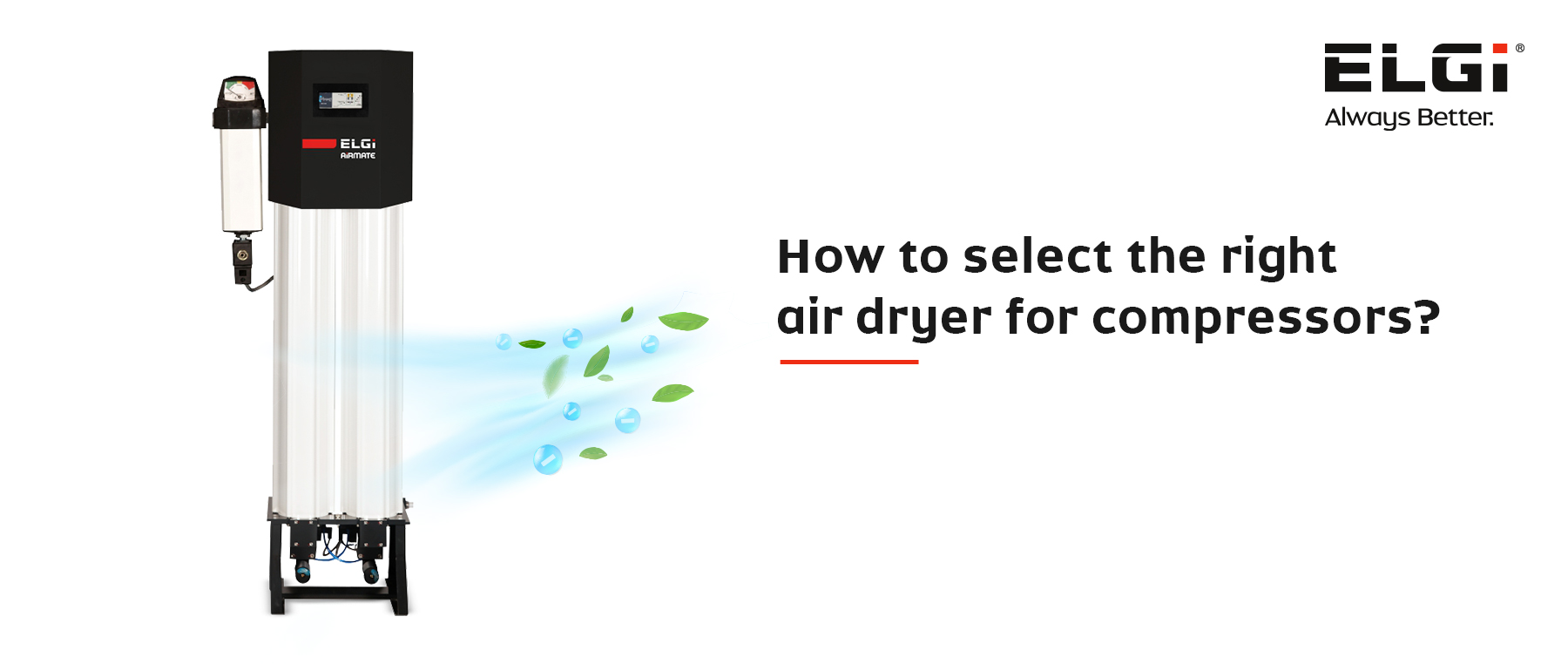An indispensable utility for your compressed air system
Water vapor in the compressed air needs to be eliminated to prevent damage & corrosion to the compressed air line & your pneumatic tools. The operational expenses may go up significantly, if this moisture is not eliminated from the system. That is why compressed air dryers are critical to industrial manufacturing processes as they help in removal of moisture from the compressed air lines.
Different dryers for diverse applications
Depending on the application, compressed air dryers come in different capacities and types. Each of these dryers is unique, with its benefits and disadvantages:
1. Refrigerated air dryers
Out of all the compressed air dryers, the refrigerated air dryer is the most popular and used across several applications.
Functions:
- Cools compressed air to very low temperatures, allowing moisture suspended in it to condense into its liquid form.
- Once the water has been removed, a dry stream of air can flow towards the application.
Application:
Useful in manufacturing & service applications that require compressed air with no detectable condensable moisture.
Benefits:
- Cost-efficient – both in purchase and maintenance.
- Resistant to airborne oil particles.
Considerations:
- Not ideal for sub-freezing temperatures.
- Have a limited dew point capacity.
2. Desiccant air dryers
They are usually the second step after a primary dryer like a refrigerated dryer.
Functions:
Utilize a porous hygroscopic medium like activated alumina, molecular sieve and silica gel to extract moisture from the air and dry it.
Applications:
Useful in moisture-sensitive industrial and commercial applications:
- Mold & bacteria prevention.
- Healthcare/medication prescription environments.
- Food processing.
- Textile manufacturing.
Benefits:
- Constant, low dew points.
- Moderate operating costs.
- Suitable for use in harsh, isolated environments.
Considerations:
- High setup costs.
- Air filtration needed to prevent desiccant degradation from suspended oils.
- Purge air is often required.
3. Deliquescent air dryers
Single Tower Desiccant dryers are used in smaller, more specialized applications where a continuous supply of clean, dry compressed air is not required.
Functions:
Utilize a porous hygroscopic medium like activated alumina, molecular sieve and silica gel to extract moisture from the air and dry it.
Applications:
Useful in moisture-sensitive industrial and commercial applications:
- Mold & bacteria prevention.
- Healthcare/medication prescription environments.
- Food processing.
- Textile manufacturing.
Functions:
- The deliquescent desiccant type of dryer uses a hygroscopic desiccant material having a high affinity for water.
- The desiccant absorbs the water vapor and is dissolved in the liquid formed.
- These hygroscopic materials are blended with ingredients to control the pH of the effluent and to prevent corrosion, caking and channeling.
Benefits:
- Low initial capital and installation cost.
- Low pressure drops.
- No moving parts.
- Requires no electrical power.
- Can be installed outdoors.
- Can be used in hazardous, dirty or corrosive environments.
Consideration:
- Limited suppression of dew point.
- Desiccant bed must be refilled periodically.
- Drainage of dissolved solution.
- Regular periodic maintenance.
- Desiccant material can carry over into down-stream piping if there is no after-filter and if the dryer is not drained regularly. Certain desiccant materials may have a damaging effect on down- stream piping and equipment.
- Some desiccant materials may melt or fuse together at temperatures above 80°F.
4. Membrane air dryers
Efficient option for compressed air drying.
Functions:
- Utilize specialized membranes containing microtubules to filter moisture.
- The microtubules retain water while a stream of the dried air is permitted to flow through to a collection unit or required application.
Applications:
Used in applications requiring dehumidification, food processing, and gas separation.
Benefits:
- Remote operation without the need for electricity.
- Quiet operation, no moving parts.
- Easy maintenance.
Considerations:
- Only be operated with uncontaminated air.
- Require regular filter changes to prevent blockages.
ELGi’s solution for moisture sensitive industries
ELGi’s Airmate Desiccant Dryer is a heatless twin tower desiccant dryer that removes moisture through absorption onto a granular desiccant bed from the air supply. As compressed air flows up through a packed bed of desiccant in tower 1, water vapor is absorbed. Meanwhile, tower 2 is rapidly depressurized, and dry purge air from the outlet of tower 1 is fed through a purge valve, expanded to near atmospheric pressure, and counter-flowed down through tower 2 to affect the regeneration of its granular desiccant bed. When the desiccant in tower 1 becomes saturated with water vapor, the air supply is switched back to tower 2 after it has been re-pressurized, and the cycle continues.
As default, all HLD models above 5X come with the following options.
Dew Point Stretch Cycle: It stretches the moisture loading time of the desiccant bed by increasing the drying time. A dew point meter at the outlet with a required dew point setting provides the signal for the stretch cycle. This reduces the purge of air per the air flow and dew point chosen. The purge occurs for the pre-programmed time during this time.
Note – Dew point meter not in dryer scope.
Purge Optimizer: It reduces the percentage of regeneration flow based on the front panel setting. It has 4 options 40%, 60%, 80% & 100% purge optimization cycles respectively. The settings correspond to flow or moisture load through the dryer. Separate LED Indicators for Tower Status, Purge Optimizer & Condensate Drain.
To make sure that you choose the ideal air dryer for your system, here are some things to keep in mind:
- Select the air quality your business requires.
- Invest in high-quality systems, resulting in cost & time efficiency.
- Get in touch with our team who can assist you in selecting the right air dryer for your compressor.




